ISSN ONLINE(2319-8753)PRINT(2347-6710)
ISSN ONLINE(2319-8753)PRINT(2347-6710)
Dharmesh M. Patoliya1, Sunil Sharma2
|
| Related article at Pubmed, Scholar Google |
Visit for more related articles at International Journal of Innovative Research in Science, Engineering and Technology
The present study deals with the investigation of effect of reinforcement (Zirconium dioxide) particles on mechanical properties of aluminium alloy (Al6061) composites, fabricated by stir casting method. The MMC’s specimens were prepared by varying weight fraction of the reinforced particles as 0 Wt.%, 2.5 Wt.%, 5 Wt.%, and 7.5 Wt.% and keeping all other parameters constant. The microstructure and mechanical properties of fabricated MMC’s were analysed. Microstructural studies of the MMC’s reveal a uniform distribution of zirconium dioxide (ZrO2) particles in the Al6061 matrix. The mechanical properties like hardness, tensile strength and impact strength were improved with the increase in weight fraction of zirconium dioxide particles in the aluminium matrix. It was observed that the elongation decrease with increase weight fraction of zirconium dioxide particles in the aluminium matrix.
Keywords |
| Metal matrix composites MMC’s, Zirconium dioxide (ZrO2), Stir casting technique |
INTRODUCTION |
| The advancement of technology requires material with an unfamiliar combination of properties that cannot be met by the metals, conventional metal alloy, ceramics and polymeric materials. A composite is a combination of two or more dissimilar materials having a distinct interface between them such that the properties of the resulting material are greater to the specific constituting components. Metal matrixcompositeconsist of superior properties are high strength, high stiffness, high elastic modulus, high electrical and thermal conductivity, high thermal stability and exhibits greater resistances to corrosion, oxidation and wear comparable to conventional material [1]. |
| Composite material is composed of two or more constituent phase: matrix phase and reinforcement phase. The discontinuous phase in composites is usually harder and stronger than continues phase and is called reinforcing agents. The continuous phase is called as the matrix. Composite materials can be categorized based on the matrix material are summarized as follows: |
| 1. Metal matrix composites Metal matrix composites are broadly used in aerospace, automobile, marine and structural application, etc., due to its outstanding mechanical properties. Metal matrix composite stands for reinforcement in a ductile metal matrix. Strength of MMC is considerable better than the strength of base metal. The super alloys and alloy of Al, Mg, Ti and Cu were working as metal matrix material. The reinforcement can be in the form of particles, continuous and discontinuous fibres. These MMC’s are very expensive, but many advantage over polymer matrix composite such as higher operating temperature, non flammability and more resistance to degradation of organic fluids. |
| 2. Polymer Matrix Composites A composite is used for polymeric composite in which matrix is of a polymer material. Polymers used in composite manufacture are epoxy, unsaturated polyesters, a few thermoplastics and some thermosetting polymers as silicones, phenolic, and polyimides. In a polymeric composite, there is a continuous resin matrix in which there is controlled distribution of reinforcements such as graphite, aramide, glass, thermoplastic fibres, metals and ceramics. High performance grades of polymer composites, i.e. with stronger matrix and continuous reinforcement have high specific strength and high specific modulus. There were further progresses in glass-epoxy composites used in items as boats, vessels and piping, because of their strength and resistance to environment. |
| 3. Ceramic matrix composites |
| Ceramic matrix composites are nominated by high melting points, good strength at high temperature, high compressive strength and excellent resistance to wear and oxidation. Fracture toughness of ceramic materials is little due to their brittle behaviour. With the development of a new generation of ceramic matrix composites, the fracture toughness is highly improved. Modern applications for ceramic matrix composites are in jet and automotive engine, equipment for deep sea mining, pressure vessels, and various structural components. |
II. LITERATURE REVIEW |
| Sachin Malhotra et al. [2] observed that influence of varying weight percentage of zirconia (5% and 10 %) and fixed percentage fly ash (10%) reinforced Al6061 metal matrix composite by stir casting method. It was identified that hardness and ultimate tensile strength increase with increase weight fraction of reinforcement material. A better hardness 94HV and tensile strength 278 MPa for 10% zirconia and 10% fly ash reinforced composite material. Aluminium alloy 6061 had the determinate elongation of 21.66%, which was significantly reduced to a range of 85% to 90% due to the addition of reinforcement material. |
| K. B. Girisha et al. [3] investigated the effect of different weight fraction of zirconium oxide nanoparticle (0.5%, 1%, 1.5%, and 2%) reinforced Al356.1 metal matrix composite by stir casting method. It was observed that particle agglomeration in composite due to high content of zirconium oxide nanoparticle. Hardness and wear properties increase with increase weight fraction of zirconium dioxide nanoparticle. |
| J. Jenix Rino et al. [4] investigated the mechanical behaviour of Al6063 alloy composite strengthened by zircon sand and alumina particle with an overall reinforcement in 8 Wt.% by stir casting method. It was observed that homogenous distribution of the reinforcement in Al6063 matrix material. Hardness and tensile strength of the composite having the higher value at the composite sample having the reinforcement mixture of 4wt.%ZrSiO4+4wt.% Al2O3. |
| K. L. Meena et al. [5] observed that mechanical properties of the developed SiC reinforced Al6063 metal matrix composite material using the melt stirring technique. The experiment was performed by varying the reinforced particle size as 200 mesh, 300 mesh, 400 mesh and different weight percentage, 5%, 10%, 15%, and 20% of SiC particle reinforced composite material. The stirring process was conceded at 200 rpm using a graphite impeller on behalf of 15 min. A homogenous dispersion of SiC particle in the aluminium matrix was observed. Tensile strength, hardness and breaking strength improved with the enlargement in reinforced particulate size and weight percentage of SiC particles. Percentage elongation, percentage reduction area and impact strength decrease with the rise in reinforced particle size and weight percentage of SiC particles. Maximum hardness (HRB) 83, and impact strength 37.01 Nm was achieved at 20% weight percentage of SiC particles. |
| Sandeep Kumar Ravesh et al. [6] studied the effect of the different weight fraction of SiC (2.5%, 5%, 7.5%, and 10%) and 5% fly ash reinforced 6061 aluminium matrix composite by stirring casting technique. Tensile strength, hardness and impact strength increased with growth in weight fraction of SiC particles. A better tensile strength 115 N/mm2, hardness 93 RHN and toughness value 7.8 for a 10% SiC and 5% Fly ash reinforced composite material was obtained. |
III. MATERIALS AND EXPERIMENTAL PROCEDURE |
| 3.1 Materials The matrix material utilized in experimental study is an aluminium alloy 6061 whose chemical composition shown in Table 1. Aluminium was purchased from Shree Balaji alumnicast Pvt Ltd, Ludhiana, Punjab, India. |
 |
| Al6061 is a precipitation toughening aluminium alloy, enclosing magnesium and silicon as its major alloying components. The mechanical properties of Al6061 rest on the temper or heat treatment of the material. Compared to other material, it offers relatively high strength, good workability, high machinability, high resistance to corrosion, and is broadly available. The reinforced material used in experimental investigation is zirconium dioxide powder whose chemical composition is listed in Table 2. The zirconium dioxide powder was purchased from Loba Chemie Pvt Ltd, India. |
 |
| Zirconium dioxide (ZrO2), sometimes known as zirconia, is a white crystalline oxide of zirconium. The density is 5.85 g/cm3 and melting point greater than 2600°C. A typical properties exhibited by zirconium dioxide are high strength, high fracture toughness, excellent wear resistance, and high hardness, etc. |
| 3.2 Experimental Procedure Stir casting is best and inexpensive out of the all available method for metal matrix composites production in large quantities and permits very large size components to be manufactured. In this technique, irregular reinforcement is stirred into molten metal. Stirrer was provides greater shearing action in addition to a vortex formation for fast and easy introduction of particle in the molten metal and helps in uniform distribution with minimum breakage. This method is also known as vertex or stirrer method. |
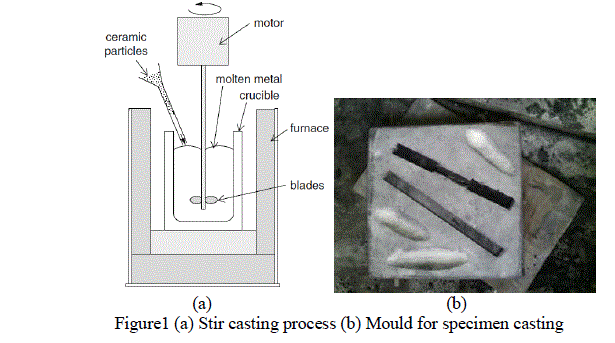 |
| Graphical representation of stir casting process was shown in Figure 1(a), consisted of a furnace and a stirrer assembly, which was utilized in composite material fabrication process. Approximately 2 Kg of Al6061 in solid form was melted in the furnace and fixed quantity of zirconium dioxide was taken in powder form in suitable crucibles. Preheating of zirconium dioxide particles was for 30 min to remove moisture and gases from surface of the particle. The stirrer was then lowered vertically up to required height in molten metal. The speed of the stirrer was maintained 500 rpm and the preheated zirconium dioxide particles were added in to molten metal and stirring was continued for 15 min for proper mixing of zirconium dioxide particle in aluminium matrix. The melt was kept in static condition and poured in the sand mould to get desired shape of different testing specimens as shown in Figure 1(b). |
 |
| MMC’s fabricated for Different weight fraction in range of 0 Wt.% to 7.5 Wt.% ZrO2 particles in Al6061 matrix. The value of ZrO2 varies from 0 Wt.% to 7.5 Wt.% and four different compositions specimens were made whose compositions are given in Table 3. |
IV. EXPERIMENTAL RESULTS |
4.1 Microstructural Characterization |
| The MMC’s were observed by inverted optical microscope. The specimen surfaces were prepared by grinding through 220 to 1500 mesh size abrasive papers and polishing with velvet cloth. After that the specimens were etched using Keller’s regent (1 ml hydrofluoric acid, 1.5 ml hydrochloric acid, 2.5 ml nitric acid and 95 ml distilled water) prior to microscopic examination [7]. |
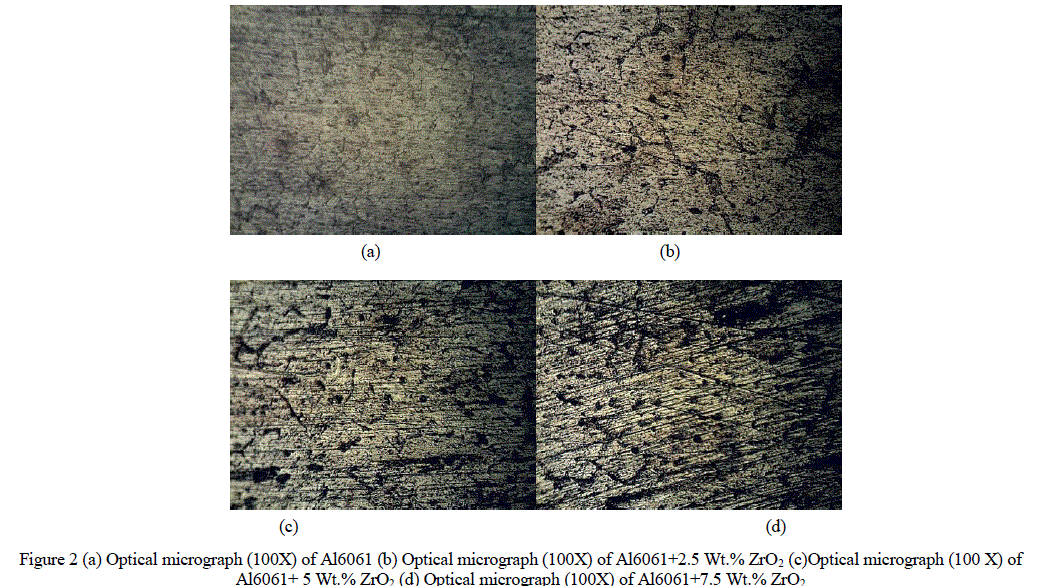 |
| An image analyser was used to observe the distribution of the zirconium dioxide particles within the aluminium matrix. Figure 2(a, b, c, d) shows micrograph of MMC’s for different weight fraction of ZrO2 particle in Al6061 matrix. The micrograph has shown a relatively uniform distribution of ZrO2 particles and good interfacial bonding between Al6061 matrix and ZrO2 particle. |
4.2 Tensile strength |
| The tensile testing was done using a computerized universal testing machine (Model:-UTE-20, Sr.No:-10/2009-4191, Max Capacity:-200KN) at room temperature. The tensile test specimens were prepared as per ASTM E8 standard (Figure 3(a)). The tested specimens of tensile test are shown in Figure 3 (b). Three specimens were tested for each trial and then the average values were utilized to calculate tensile strength and ductility in terms of elongation. |
 |
| Figure 4(a) graph shows the effect of weight fraction of ZrO2 on the tensile strength. Results show an increase tensile strength with increase in weight fraction of zirconium dioxide (ZrO2) particles in Al6061 matrix. Tensile strength of unreinforced Specimen A (Al6061) is 141 MPa and this value increase to a maximum of 156.5 MPa for Specimen D (Al6061+ 7.5 Wt.% ZrO2). |
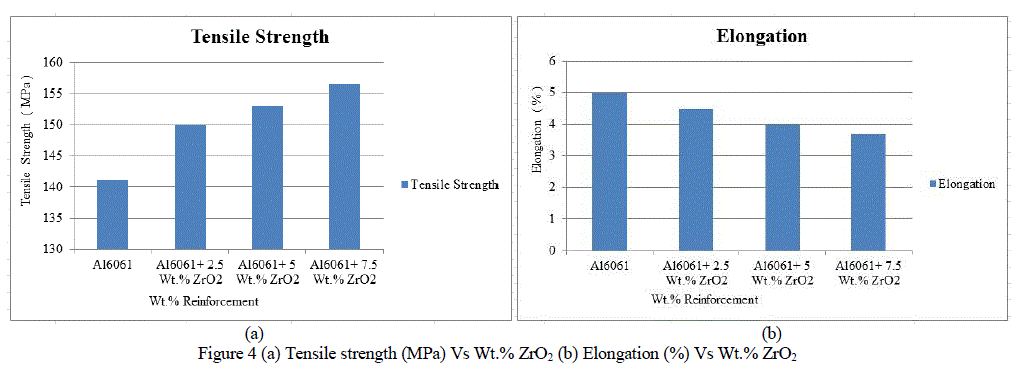 |
| Figure 4(b) shows the graph of the experimental elongation of zirconium dioxide reinforced aluminium metal matrix material. It is experimentally detected that the elongation of MMC’s were gradually decreased with increased weight fraction of zirconium dioxide (ZrO2) particles in Al6061 matrix. Elongation of specimen A (Al6061) is observed as 5%, this value is decreased to 3.7% for specimen D (Al6061+7.5 Wt.% ZrO2). |
4.3 Hardness |
| Hardness test was carried out at room temperature using Rockwell hardness tester (Model:- AI-RAS, SR.No:-163- 2009/10, Make:- Arun Industries, Maharashtra, India). 1.58 mm ball is utilised for measuring hardness. A flat specimen is prepared for test and polished well for different weight fraction of zirconium dioxide reinforced aluminium matrix composites. It should be clean, dust free and free from oil and scale, etc. |
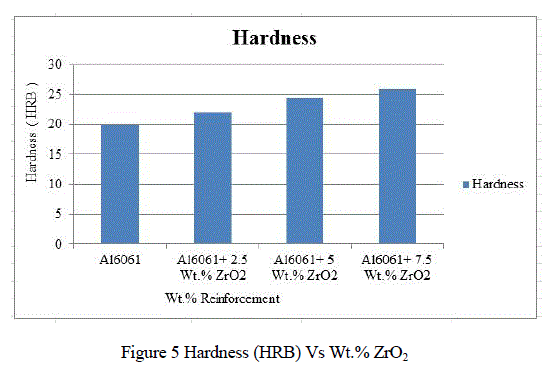 |
| Figure 5 shows the comparison of the experimental hardness of the MMC’s in HRB. It is observed that the increase weight fraction of zirconium dioxide (ZrO2) particles in Al6061 matrix. The presence of such hard surface area of particles offers more resistance to plastic deformation which leads to increase in the hardness of MMC’s. The hardness of specimen A (Al6061) is 20 HRB, it increase with increase in weight fraction of ZrO2and reaches a maximum value of 26 HRB for specimen D (Al6061+ 7.5 Wt.% ZrO2). |
4.4 Impact strength |
| Impact strength was carried out at room temperature using impact testing machine. The size of the specimen for the impact charpy test was 10 mm × 10 mm × 55 mm with a notch size of 2 mm. |
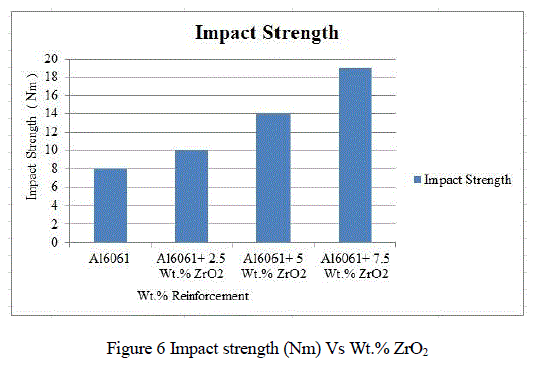 |
| Charpy impact test is a standardized high strain rate test which determines the amount of energy absorbed by a material during fracture. Figure 6 shows the graph of the experimental impact strength results of zirconium dioxide particle reinforced aluminium metal matrix material. As shown in graph the impact strength of specimen A (Al6061) is 8 Nm, it increase with increase in weight fraction of ZrO2 particles and reaches a maximum value of 19 Nm for specimen D (Al6061+ 7.5 Wt.% ZrO2). |
V. CONCLUSION |
| Aluminium based metal matrix composites have been successfully fabricated by stir casting technique with uniform distribution of zirconium dioxide particles. Tensile strength, hardness and impact strength of MMC’s was improved with increase weight fraction of ZrO2 particle in Al6061 matrix. The percentage elongation of the MMC’s decreased with increase in ZrO2 content, which confirmed that ZrO2 addition increased brittleness. |
References |
|